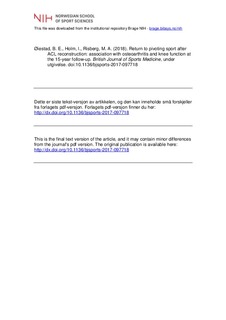| dc.contributor.author | Øiestad, Britt Elin | |
| dc.contributor.author | Holm, Inger | |
| dc.contributor.author | Risberg, May Arna | |
| dc.date.accessioned | 2018-09-05T09:57:22Z | |
| dc.date.available | 2018-09-05T09:57:22Z | |
| dc.date.created | 2018-05-07T10:10:52Z | |
| dc.date.issued | 2018 | |
| dc.identifier.citation | British Journal of Sports Medicine. 2018, 52, 1199-1204. | nb_NO |
| dc.identifier.issn | 0306-3674 | |
| dc.identifier.uri | http://hdl.handle.net/11250/2560890 | |
| dc.description | I Brage finner du siste tekst-versjon av artikkelen, og den kan inneholde ubetydelige forskjeller fra forlagets pdf-versjon. Forlagets pdf-versjon finner du på bjsm.bmj.com / In Brage you'll find the final text version of the article, and it may contain insignificant differences from the journal's pdf version. The definitive version is available at bjsm.bmj.com | nb_NO |
| dc.description.abstract | Abstract Objectives To examine the associations between return to pivoting sport following ACL reconstruction (ACLR) and knee osteoarthritis (OA), and self-reported knee symptoms, function and quality of life after 15 years. Methods Study sample included 258 participants with ACLR 15 years previously. Return to pivoting sport (handball, soccer and basketball) data were collected by interviews, and symptomatic OA was defined as Kellgren and Lawrence grade ≥2 plus almost daily knee pain in the last month. Self-reported symptoms, function and quality of life were assessed with the Knee Injury and Osteoarthritis Outcome Score. Adjusted regression models were used to analyse the associations between return to pivoting sport and OA (present or not), and self-reported outcomes. P values ≤0.05 were considered statistically significant. Results Two hundred and ten (81%) participants (57% men) with a mean age of 39.1 (±8.7) years completed the 15-year follow-up, and 109 (52%) had returned to pivoting sport. Returning to pivoting sport was associated with less symptomatic OA (OR 0.28, 95% CI 0.09 to 0.89) and radiographic OA (OR 0.40, 95% CI 0.17 to 0.98), adjusted for age, sex, combined injury, self-reported knee function, and time between injury and surgery. Those who returned to pivoting sport had better function in activities of daily living (ADL). Conclusion The participants with ACLR who returned to pivoting sport had lower odds of knee OA and better self-reported ADL function. Further investigation is required to understand the clinical significance of these findings. | nb_NO |
| dc.language.iso | eng | nb_NO |
| dc.title | Return to pivoting sport after ACL reconstruction: association with osteoarthritis and knee function at the 15-year follow-up | nb_NO |
| dc.type | Journal article | nb_NO |
| dc.type | Peer reviewed | nb_NO |
| dc.description.version | acceptedVersion | nb_NO |
| dc.source.pagenumber | 7 | nb_NO |
| dc.source.journal | British Journal of Sports Medicine | nb_NO |
| dc.identifier.doi | 10.1136/bjsports-2017-097718 | |
| dc.identifier.cristin | 1583804 | |
| dc.description.localcode | Seksjon for idrettsmedisinske fag / Department of Sports Medicine | nb_NO |
| cristin.unitcode | 150,34,0,0 | |
| cristin.unitname | Seksjon for idrettsmedisinske fag | |
| cristin.ispublished | true | |
| cristin.fulltext | postprint | |
| cristin.qualitycode | 2 | |
